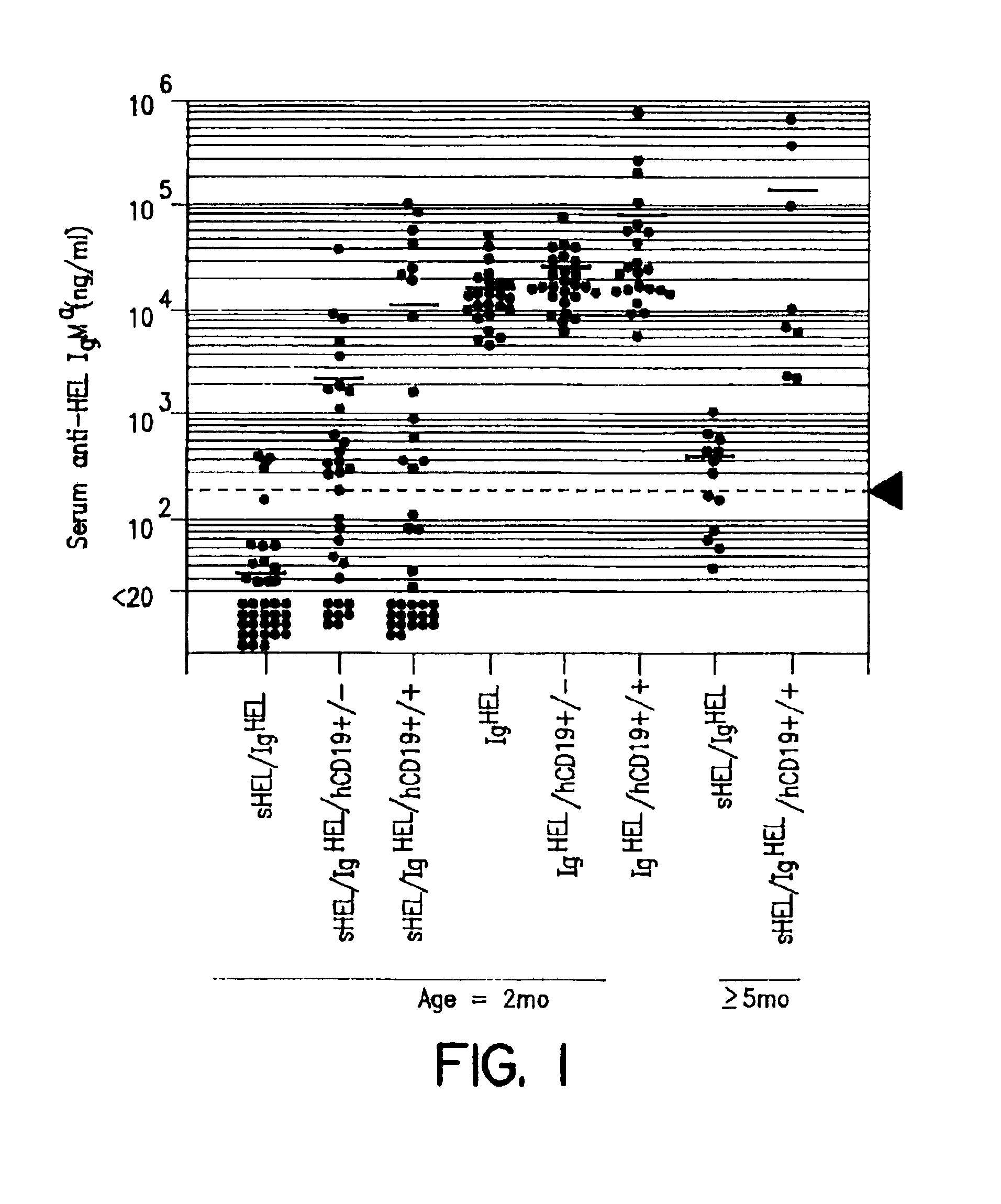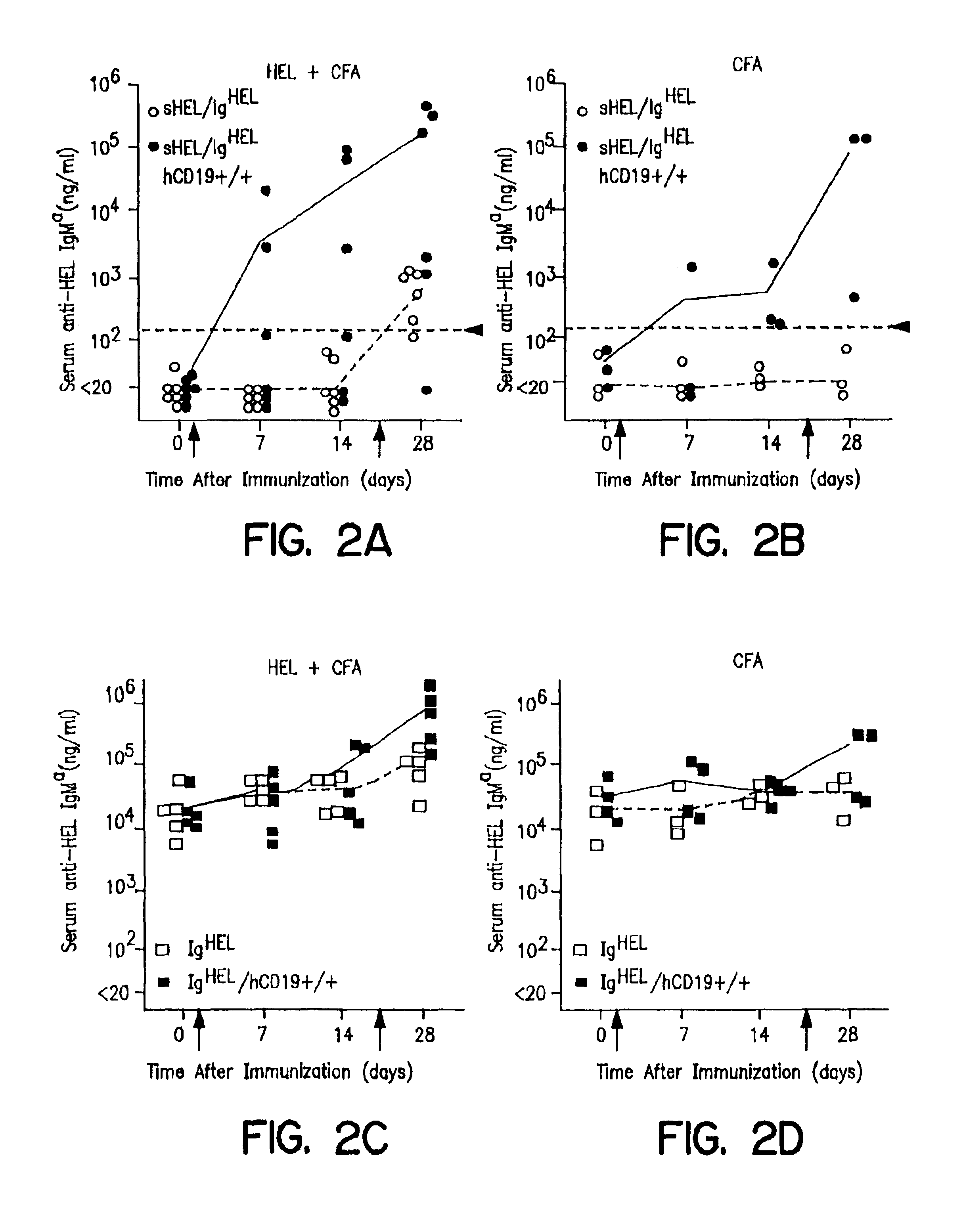Antibody production methods relating to disruption of peripheral tolerance in B lympho-cytes
a peripheral tolerance and antibody technology, applied in the field of monoclonal antibody production, can solve the problems of ineffective production of antibodies against such highly conserved epitopes by conventional animals, difficult screening procedures, and difficult detection procedures
- Summary
- Abstract
- Description
- Claims
- Application Information
AI Technical Summary
Benefits of technology
Problems solved by technology
Method used
Image
Examples
example 1
CD19-Regulated Signaling Thresholds Control Peripheral Tolerance and Autoantibody Production in B Lymphocytes
[0128]B lymphocyte tolerance to self antigens is achieved by the negative selection and elimination of immature B cells that express high-affinity IgM receptors for autoantigens. Goodnow, C. C. (1996) Proc. Natl. Acad. Sci. USA 93:2264-2271; Hartley et al. (1993) Cell 72:325-335; Nemazee et al. (1989) Nature 337:562-566; Goodnow, C. C. (1992) Annu. Rev. Immunol. 10:489-518. Negative selection is antigen receptor-dependent but also relies on established triggering thresholds for intracellular signals (Goodnow, C. C. (1996) Proc. Natl. Acad, Sci. USA 93:2264-2271; Klinman, N. R. (1996) Immunity 5:189-195). If antigen receptor ligation generates inadequate intracellular signals because of a low affinity for autoantigens, or the valency or concentration of autoantigen is low, autoreactive B cells mature and leave the bone marrow but are rendered functionally anergic. Goodnow, C. ...
example 2
Preparation of Monoclonal Antibodies against Prion Epitopes
[0164]As discussed above, monoclonal antibodies (mAbs) have become powerful tools in research and biotechnology. In these areas, as in the acquisition of immunity, production of potentially useful antibodies often depends on two aspects of “self”-“non-self” discrimination during the antibody response in mice. First, antibodies are not normally produced against self antigens, and secondly, antibodies to foreign antigens are normally directed exclusively at regions of the foreign antigen that differ from self. The number of monoclonal antibodies generated against species-specific antigens for use in sensitive immunoassays or allele-specific antibodies for blood grouping and tissue typing before transfusion or organ transplantation has been quite significant. However, the true potential of monoclonal antibodies has not been realized in many cases because of the difficulty in generating antibodies directed to self antigens or an...
example 3
Preparation of a Non-Human Animal having an Immune System with Desired Characteristics
[0186]Example 1 describes breeding of transgenic mice, including a transgenic mouse which over-expresses CD19, wherein progeny of such mice possess antibody-forming cells having disrupted peripheral tolerance. Given the disclosure of Example 1, then, a practitioner having ordinary skill in the art can breed and / or prepare lines transgenic mice for cross-breeding, wherein each line of mice have immune systems with certain characteristics, to produce progeny animals having combinations of the characteristics. Such animals would be very useful, inter alia, in the preparation of monoclonal antibodies as described herein or in the preparation of vaccines. This Example describes the preparation of such an animal.
[0187]An example of a desirable characteristic is hyper-sensitivity to antigens so that antibodies, and particularly monoclonal antibodies, can be made against epitopes that are highly conservati...
PUM
| Property | Measurement | Unit |
|---|---|---|
| Van der Waals' coefficient b | aaaaa | aaaaa |
| Fraction | aaaaa | aaaaa |
| Fraction | aaaaa | aaaaa |
Abstract
Description
Claims
Application Information
 Login to View More
Login to View More - R&D
- Intellectual Property
- Life Sciences
- Materials
- Tech Scout
- Unparalleled Data Quality
- Higher Quality Content
- 60% Fewer Hallucinations
Browse by: Latest US Patents, China's latest patents, Technical Efficacy Thesaurus, Application Domain, Technology Topic, Popular Technical Reports.
© 2025 PatSnap. All rights reserved.Legal|Privacy policy|Modern Slavery Act Transparency Statement|Sitemap|About US| Contact US: help@patsnap.com



